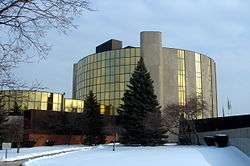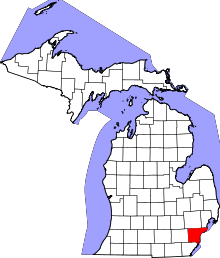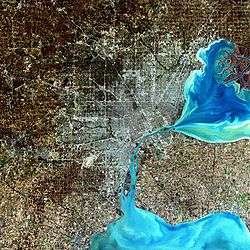Livonia, Michigan
| Livonia, Michigan | |
|---|---|
| City | |
| City of Livonia | |
|
Livonia City Hall | |
| Nickname(s): L-Town | |
 Location of Livonia within Michigan | |
 Livonia, Michigan Location in the United States | |
| Coordinates: 42°23′50″N 83°22′25″W / 42.39722°N 83.37361°WCoordinates: 42°23′50″N 83°22′25″W / 42.39722°N 83.37361°W | |
| Country | United States |
| State | Michigan |
| County | Wayne |
| Government | |
| • Type | City |
| • Mayor | Dennis K. Wright |
| Area[1] | |
| • City | 35.86 sq mi (92.88 km2) |
| • Land | 35.70 sq mi (92.46 km2) |
| • Water | 0.16 sq mi (0.41 km2) |
| Elevation | 640 ft (206 m) |
| Population (2010)[2] | |
| • City | 96,942 |
| • Estimate (2012[3]) | 95,586 |
| • Density | 2,715.5/sq mi (1,048.5/km2) |
| • Metro | 4,285,832 (Detroit metro) |
| Time zone | EST (UTC-5) |
| • Summer (DST) | EDT (UTC-4) |
| ZIP codes | 48150-48154 |
| Area code(s) | 734, 248 |
| FIPS code | 26-49000 |
| GNIS feature ID | 0630841[4] |
| Website | http://www.ci.livonia.mi.us/ |
Livonia is a city in the northwest part of Wayne County in the U.S. state of Michigan. Livonia is a large suburb with an array of traditional neighborhoods (most of which were built in the 1950s and 1960s) connected to the metropolitan area by freeways. The population was 96,942 at the 2010 census, making it Michigan's ninth largest municipality.[5] The municipality is a part of Metro Detroit, and is located approximately 15 miles (24 km) northwest of downtown Detroit, and less than two miles (3 km) from the western city limits of Detroit (Redford Township lies between the two).
History
First settled by pioneers from New England and New York, an act by the Legislature of the Territory of Michigan established the borders of Livonia Township on March 17, 1835. The settlers brought with them the name "Livonia", a name that had already been given to Livonia, New York, Livonia, Pennsylvania and a region of the Baltic Sea named Livonia in present-day Estonia and Latvia, from which many early settlers came.[6][7][8]
During the days of the city being a township, many small communities have existed. One of these was Elmwood, initially known as McKinley's Station. It was a stop on the Detroit, Lansing and Northern Railroad. It had a post office from 1858 until 1906.[9] There was a post office in the township named Giltedge from 1899 until 1902.[10]
Livonia was incorporated into a city on May 23, 1950, by vote of the citizens of the township. A significant motivation was to gain tax revenues from the DRC (Detroit Race Course), which was Michigan's only thoroughbred horse race track; it closed in 1998.
Six U.S. presidents have visited the city: Richard Nixon, Gerald Ford, Ronald Reagan, George H. W. Bush, Bill Clinton and George W. Bush.[11]
Economy
In addition to its schools, colleges, churches, parks, recreation center, libraries and the St. Mary Mercy Hospital, Livonia also has commercial and industrial sectors, restaurants and retail stores. Laurel Park Place, an upscale fashion mall with 74 stores, was built in 1989 at 6 Mile Road and Newburgh Road. Carson's and Von Maur department stores serve as anchors.
The city previously featured two other malls which have since been dismantled. Wonderland Mall was the first, opening in 1959 and closing in 2003; it was replaced with a development called Wonderland Village, anchored by Walmart and Target. Livonia Mall was built to the north in 1964. It also closed in 2008 and was redeveloped as Livonia Marketplace, featuring a second Walmart, along with Sears and Kohl's. Other big-box stores are located near Laurel Park Place.
Livonia is home to the Livonia Hockey Association, the largest amateur hockey association in Michigan, as well as two-time state champions the Livonia Knights. The city also boasts the Livonia City Soccer Club (LCSC), one of the largest soccer programs in the state with 1,300 participants. Livonia is also home to the Evangelical Presbyterian Church (EPC).

Major employers and business establishments
|
|
Education
Colleges and universities
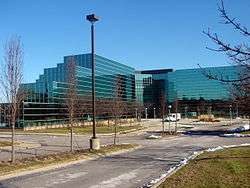
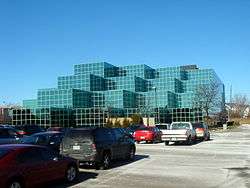
Livonia is home to various private and public colleges and universities, including Madonna University, Schoolcraft College, a small University of Phoenix campus, and a Continuing Education Center of Eastern Michigan University. The most recent university to open in Livonia is a Davenport University campus, which opened on September 26, 2008.
- Madonna University
- Schoolcraft Community College
- Davenport University
- Eastern Michigan University (Livonia Campus)
Primary and secondary schools
Public schools
Most of Livonia is served by the Livonia Public Schools district, consisting of two early childhood centers, thirteen elementary schools, four upper elementary Schools, three middle schools and three high schools. The district also serves students in portions of Westland. A portion of northeast Livonia is served by the Clarenceville School District.
There are currently five high schools in Livonia, four of which are public: Franklin, Churchill and Stevenson high schools in the Livonia Public Schools district; Clarenceville High School in the Clarenceville Public School District; and Ladywood High School, a Catholic all-girls private school run by the Felician Sisters. Bentley High School, the first one built in the district, closed in 1985.
Each high school in the Livonia Public School District offers a different educational program. Stevenson High School is the home of the school of Global Education, an alternative education model which combines students' English and social studies classes with a focus on the student's role in the world. Churchill houses the MSC (Math/Science/Computer) and CAPA (Creative and Performing Arts) programs. Franklin currently offers an International Baccalaureate program for select students.
Frost Middle School houses the Middle School Alternative Classrooms for the Academically Talented (MACAT) program. The public K-6 Webster Elementary School is home to the Alternative Classrooms for the Academically Talented (ACAT) program, as well as many after-school programs. Webster also has classess for disabled children. In 2008, the original Webster school was burned down by an arsonist, and Webster was moved to a closed-down school, Tyler Elementary.
- Clarenceville School District
- Livonia Public Schools (LPS also serves parts of Westland.)
- Academy of Westland Charter Schools (In Westland, but serving Livonia)[13]
- Warren Dale Charter Academy (In Detroit, but serving Livonia)[14]
- CAPA, a performance art program at Churchill high school[15]
- MSC (Math, Science, Computers) a program for the academically gifted housed at Churchill High School accepting only 30 students a year and 12 alternates
The Hinoki International School, a two-way Japanese-English immersion charter elementary school, was once located in Livonia.[16] Originally named the Japanese American School of South East Michigan (JASSEM, 南東ミシガン日米学校 Nantō Mishigan Nichibei Gakkō (ジャシム Jashimu)),[17][18] it opened in September 2010 as a charter school authorized by Livonia Public Schools. Until 2014, it was housed in the former Taylor Elementary School, until forced to move by LPS, when the district created its own Japanese bilingual-immersion program in its place.
Private schools
There are a number of parochial grade schools attached to Catholic and Lutheran churches around Livonia, including:
- Ladywood High School
- St. Edith, St. Genevieve and St. Michael Catholic grade schools
- St. Paul's Lutheran school is Pre-K through 8th grade and affiliated with the Wisconsin Evangelical Synod (WELS) (http://www.stpaulslivonia.org)
Public libraries
The Livonia Public Library includes the Civic Center Library, the Alfred Noble Library, the Carl Sandburg Library, and the Vest Pocket Library.[19]
Geography
According to the United States Census Bureau, the city has a total area of 35.86 square miles (92.88 km2), of which 35.70 square miles (92.46 km2) is land and 0.16 square miles (0.41 km2) is water.[1]
Transportation
Livonia has limited access to public bus service through the Detroit Department of Transportation.
In 2012, the National Motorists Association released the results of a public poll on the "Worst Speed Trap Cities" in North America. Livonia was listed at #2.[20]
Politics
Livonia's mayor is Dennis K. Wright. The city is located in Michigan's 11th congressional district. Livonia is in Michigan's 7th State Senate District, and is represented by Patrick Colbeck (Republican).
Most of Livonia makes up Michigan's 19th State House District which elected Laura Cox (Republican) in 2014. A part of southeast Livonia is in the 11th district which also elected a freshman in 2014, Julie Plawecki (Democrat).
Demographics
| Historical population | |||
|---|---|---|---|
| Census | Pop. | %± | |
| 1900 | 1,460 | — | |
| 1910 | 1,365 | −6.5% | |
| 1920 | 1,608 | 17.8% | |
| 1930 | 3,192 | 98.5% | |
| 1940 | 8,728 | 173.4% | |
| 1950 | 17,634 | 102.0% | |
| 1960 | 66,702 | 278.3% | |
| 1970 | 110,109 | 65.1% | |
| 1980 | 104,814 | −4.8% | |
| 1990 | 100,850 | −3.8% | |
| 2000 | 100,545 | −0.3% | |
| 2010 | 96,942 | −3.6% | |
| Est. 2015 | 94,635 | [21] | −2.4% |
| U.S. Decennial Census 2011 estimate | |||
According to a 2010 American Community Survey, the median income for a household in the city was $65,391, and the median income for a family was $77,119. Males had a median income of $62,071 versus $42,083 for females. The per capita income for the city was $29,536. About 5.4% of families and 7.8% of the population were below the poverty line, including 15.6% of those under age 18 and 3.8% of those age 65 or over.
By 1985,[22] and as of 2005, there is a group of Christian Palestinian Americans, many of whom operated small and medium-sized businesses, who originated from Ramallah.[23]
2010 census
As of the census[2] of 2010, there were 96,942 people, 38,714 households, and 26,856 families residing in the city. The population density was 2,715.5 inhabitants per square mile (1,048.5/km2). There were 40,401 housing units at an average density of 1,131.7 per square mile (437.0/km2). The racial makeup of the city was 92.0% White, 3.4% African American, 0.2% Native American, 2.5% Asian, 0.4% from other races, and 1.4% from two or more races. Hispanic or Latino of any race were 2.5% of the population.
There were 38,714 households of which 29.1% had children under the age of 18 living with them, 55.9% were married couples living together, 9.7% had a female householder with no husband present, 3.8% had a male householder with no wife present, and 30.6% were non-families. 26.7% of all households were made up of individuals and 13.1% had someone living alone who was 65 years of age or older. The average household size was 2.47 and the average family size was 3.01.
The median age in the city was 44.5 years. 20.8% of residents were under the age of 18; 7.6% were between the ages of 18 and 24; 22.2% were from 25 to 44; 31.5% were from 45 to 64; and 17.7% were 65 years of age or older. The gender makeup of the city was 48.3% male and 51.7% female.
2000 census
As of the census[24] of 2000, there were 100,545 people, 38,089 households, and 28,071 families residing in the city. The population density was 2,815.0 per square mile (1,086.8/km2). There were 38,658 housing units at an average density of 1,082.3 per square mile (417.9/km2). The racial makeup of the city was 95.45% White, 0.95% African American, 0.22% Native American, 1.94% Asian, 0.01% Pacific Islander, 0.32% from other races, and 1.11% from two or more races. Hispanic or Latino of any race were 1.72% of the population. 16.3% were of Polish, 15.9% German, 11.2% Irish, 8.6% Italian and 8.5% English ancestry according to Census 2000. Livonia has a substantial Middle Eastern population mostly Arab and trace their ancestry to the Levant region, mainly from Syria, Jordan, Palestine, and Lebanon, and are of the Christian faith. The Arab-American community has few churches in the city, Mainly Saint Mary's Antiochian Orthodox Christian Church. The community settled in Livonia in the late 1960s and has since continued a steady growth.
There were 38,089 households out of which 32.5% had children under the age of 18 living with them, 62.8% were married couples living together, 8.0% had a female householder with no husband present, and 26.3% were non-families. 22.9% of all households were made up of individuals and 11.1% had someone living alone who was 65 years of age or older. The average household size was 2.59 and the average family size was 3.07.
In the city the population was spread out with 23.8% under the age of 18, 6.3% was from 18 to 24, 28.7% was from 25 to 44, 24.3% was from 45 to 64, and 16.9% were 65 years of age or older. The median age was 40 years. For every 100 females there were 94.0 males. For every 100 females age 18 and over, there were 90.8 males.
As of 2000, Livonia was the city in the United States with over 100,000 people that had the highest percentage of non-Hispanic white people.[25]
Media
The Metro Detroit-area newspapers are the Detroit Free Press and The Detroit News. The Livonia Observer prints twice a week on Thursdays and Sundays.[26]
The newspaper Between The Lines and the website PrideSource, published by Pride Source Media Group, LLC (PSMG), are headquartered in Livonia. The company opened in 1995.[27]
Notable people
- FP Santangelo, Major League Baseball Player 1995-2001
- Janet M. Anderson, commercial artist who depicted Detroit
- Chuck Behler, musician, drummer for Megadeth 1987–1989
- Bernie Carbo, Major League Baseball outfielder from 1969 to 1980 (Franklin High School Class of 1965)
- Charlie Collins, member of the Arkansas House of Representatives from Fayetteville
- Chris Conner, professional hockey player for the Washington Capitals
- Mike Cox, former Attorney General of Michigan
- Warren Defever, musician and producer
- Mike Donnelly, professional hockey player for five NHL teams
- Judy Greer, actress
- Charlie Haeger, pitcher for three Major League Baseball teams
- Al Iafrate, professional hockey player for four NHL teams
- Ryan Kesler,[28] professional hockey player for the Anaheim Ducks
- Adam Krug (born 1983), professional hockey player and coach
- Torey Krug (born 1991), professional hockey player for the Boston Bruins
- Jeff Lerg, professional hockey player for the New Jersey Devils
- Mike Modano, professional hockey player, inducted in Hockey Hall of Fame
- Cecilia Munoz. director of the White House Domestic Policy Council
- David Moss, hockey player for the Phoenix Coyotes
- Aaron Palushaj, hockey player for the Carolina Hurricanes
- Dana Schutz, painter
- Tim Shaw, professional football player for four NFL teams
- Chris Tancill, professional hockey player for four NHL teams
- Sheila Taormina, athlete, 1996 Summer Olympics swimming gold medalist in 4 x 200 meter freestyle relay; four-time Olympian (1996, 2000, 2004, and 2008 Summer Olympics); first woman to qualify in three different Olympic sports events (freestyle swimming, triathlon and modern pentathlon.)[29]
- Ken Westerfield, Disc sport (Frisbee) pioneer, athlete
- Jonathan B. Wright, stage and film actor
Images
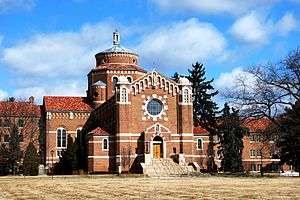 Chapel (1961) of the Felician Sisters in Livonia, Michigan - architectural sculpture by Corrado Parducci.
Chapel (1961) of the Felician Sisters in Livonia, Michigan - architectural sculpture by Corrado Parducci.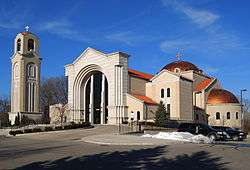 Saint Mary's Antiochian Orthodox Christian Church.
Saint Mary's Antiochian Orthodox Christian Church. St. Mary Mercy Hospital
St. Mary Mercy Hospital Entrance to neighborhood at Berwick and Plymouth in Rosedale Gardens Historic District.
Entrance to neighborhood at Berwick and Plymouth in Rosedale Gardens Historic District. Street scene on Auburdale in Rosedale Gardens Historic District.
Street scene on Auburdale in Rosedale Gardens Historic District. Street scene on Auburdale in Rosedale Gardens Historic District.
Street scene on Auburdale in Rosedale Gardens Historic District.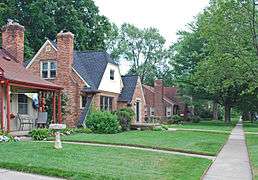
- Orson Everitt House historic site.
References
- 1 2 "US Gazetteer files 2010". United States Census Bureau. Retrieved 2012-11-25.
- 1 2 "American FactFinder". United States Census Bureau. Retrieved 2012-11-25.
- ↑ "Population Estimates". United States Census Bureau. Retrieved 2013-06-03.
- ↑ U.S. Geological Survey Geographic Names Information System: Livonia, Michigan
- ↑ Population of Michigan Cities, Villages, Townships, and Remainders of Townships: 2000 and 2010. www.michigan.gov.
- ↑ City of Livonia.History.Retrieved on January 11, 2009.
- ↑ Romig, Walter (1986) [1973]. Michigan Place Names. Detroit, Michigan: Wayne State University Press. ISBN 0-8143-1838-X.
- ↑ MacGregor, David (2005). "Introduction". Livonia: Michigan. Charleston, SC: Arcadia Publishing. pp. 7–8. ISBN 0-7385-3425-0. Retrieved 2008-11-25.
- ↑ Walter Romig, Michigan Place Names, p. 182
- ↑ Romig, Michigan Place Names, p. 224
- ↑ "President Bush's Visit - Beaver Aerospace & Defense". beaver-online.com.
- 1 2 3 4 5 6 "Livonia Michigan Community and Demographic Information". Retrieved July 3, 2009.
- ↑ http://www.greatschools.net/modperl/browse_district/85/mi/
- ↑ http://www.heritageacademies.com/Brix?pageID=407
- ↑ http://www.starringcapa.com
- ↑ "Home." Hinoki International School. Retrieved on March 4, 2014.
- ↑ "About Us." Hinoki International School. Retrieved on March 4, 2014.
- ↑ Smith, Karen. "Livonia district eyes charter school." The Livonia Observer. June 18, 2010. Retrieved on March 4, 2014.
- ↑ "Hours and Locations." Livonia Public Library. Retrieved on March 29, 2010.
- ↑ "Nationwide Poll Reveals Top U.S. and Canadian Speed Traps" (PDF). National Motorists Association. August 28, 2012.
- ↑ "Annual Estimates of the Resident Population for Incorporated Places: April 1, 2010 to July 1, 2015". Retrieved July 2, 2016.
- ↑ Present Tense, Volumes 13-15. American Jewish Committee, 1985. p. 36. "Palestinian Christians, in the western suburbs of Farmington, Livonia and Westland;"
- ↑ Hassoun, Rosina J. Arab Americans in Michigan (Discovering the Peoples of Michigan). MSU Press, October 24, 2005. ISBN 1609170466, 9781609170462. p. PT21 of Google Books.
- ↑ "American FactFinder". United States Census Bureau. Retrieved 2008-01-31.
- ↑ "Race and Ethnicity in the Tri-County Area: Selected Communities and School Districts." (Archive) From a Child's Perspective: Detroit Metropolitan Census 2000 Fact Sheets Series. Wayne State University. June 2002. Volume 2, Issue 2. p. 1. Retrieved on November 10, 2013.
- ↑ http://www.hometownlife.com/news/observer-livonia/
- ↑ "About Us." PrideSource. Retrieved on April 14, 2014. "Mailing address Pride Source Media Group Between The Lines Newspaper 20222 Farmington Road Livonia, Michigan 48152"
- ↑ NHL Players from Livonia, Michigan | QuantHockey.com Last retrieved on March 19, 2011
- ↑ Merrill, Elizabeth (August 22, 2008). "Taormina takes solace in knowing she didn't quit on her Olympic dream". ESPN. Retrieved March 19, 2011.
Further reading
- Cantor, George (2005). Detroit: An Insiders Guide to Michigan. University of Michigan Press. ISBN 0-472-03092-2.
- Fisher, Dale (2003). Building Michigan: A Tribute to Michigan's Construction Industry. Grass Lake, MI: Eyry of the Eagle Publishing. ISBN 1-891143-24-7.
- Fisher, Dale (2005). Southeast Michigan: Horizons of Growth. Grass Lake, MI: Eyry of the Eagle Publishing. ISBN 1-891143-25-5.
External links
| Wikivoyage has a travel guide for Livonia. |
| Wikimedia Commons has media related to Livonia, Michigan. |
- Official site, City of Livonia.
- Livonia Police Department.
- Livonia Public Library.
- Livonia Plymouth Road Development Authority.
- Livonia Chamber of Commerce.
- the Livonia Michigan online resource.
